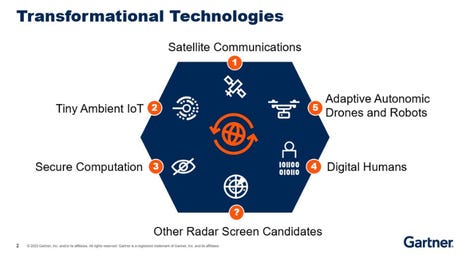5 technologies that will transform companies, according to Gartner


The adoption of new technologies can help companies transform their business processes in order to increase productivity and profitability. Gartner has identified five technologies that companies should consider adopting to achieve these new business capabilities.
The five technologies identified by Gartner are the following :
- The digital man
- Satellite communications
- The miniature and ambient IoT (Internet of Things)
- The secure calculation
- Autonomous robots
These technologies were chosen because of their broad scope and their ability to transform the digital future of organizations.
“These five technologies are potentially transformative and should be studied now because of their broad scope and their ability to create new business models or significant new capabilities,” said Nick Jones, vice president and distinguished analyst at Gartner.

Gartner
Satellite communications
Satellite communications refers to a technology like SpaceX’s Starlink that provides low latency connectivity to Earth from Low Earth Orbit (LEO) satellites.
LEO technology is attracting increasing interest because it can revolutionize the way people and companies communicate.
“The industry is still nascent and we expect it to evolve a lot. It is therefore appropriate to take a cautious approach before embarking on LEO technology, as it is an emerging technology in a complex market,” said Mr Jones.
Gartner identifies potential use cases for LEO for enterprises, such as direct satellite connection for small IoT devices and broadband coverage for remote locations.
Miniature and ambient IoT devices
The Internet of Things (IoT) refers to the communication and sharing of data between physical devices in real time in order to create an ecosystem of devices that are interconnected and constantly working, and therefore powered not by batteries but by constant electric current.
The concept of “Tiny ambient IoT”, as described by Gartner, “allows the marking, tracking and detection of any object without the complexity or cost of battery-powered devices”.
In particular, moving away from battery-powered devices allows you to get more information about more things at a lower cost, which can lead to benefits such as new ecosystems, new business models and more innovative products, according to Gartner.
The research firm warns, however, that before adopting this technology, companies must evaluate social and regulatory issues.
Secure calculations
Data protection is more critical than ever, as the interconnectivity of devices continues to grow, as do the risks of sensitive data disclosure. Secure calculation is a technology that allows users to perform calculations on data while keeping the nature of the calculations encrypted and therefore secure.
According to Gartner, the implementation of secure computing is a challenge for companies due to costs, skills and performance, but emerging technologies such as optical accelerators will be crucial to enable deployment.
The digital man
Even if the generic term generative AI is not specifically on the list, the concept of digital human, a subset of generative AI, is on it. Digital humans are human representations created by AI that embody a real person in different aspects, such as personality, physique, humor, knowledge, etc.
Many companies have adopted some form of digital human to stimulate engagement and respond to the interest that AI is currently generating. An example is Kuki, an AI character created by ICONIQ who has been used as a brand ambassador for H&M, posed for Vogue, has his own Roblox game and has even partnered with Viber.
Gartner warns companies when implementing digital humans, as they may be prone to inappropriate behaviors (prejudices and stereotypes), as shown by the rise of AI chatbots. Therefore, the establishment of rules is necessary.
Autonomous and adaptive drones and robots
This term refers to robots or drones capable of performing functions on their own with little or no human intervention and adapting to different environments.
These devices will be able to help companies in many ways, including lifting objects, monitoring, data entry, supervision, etc. Several attempts have been made to create this type of robots, including Tesla’s Optimus and Apptronik.
Of course, Gartner warns of the many challenges associated with these types of technologies, such as the limits of what they can and cannot do and the commercial, legal and ethical consequences.
Source: “ZDNet.com “








